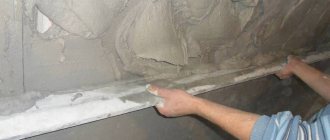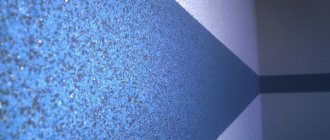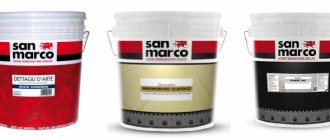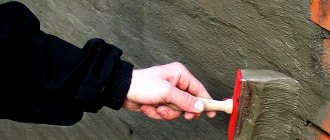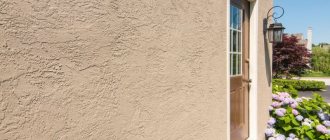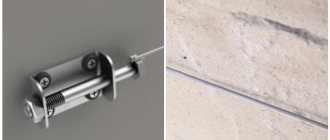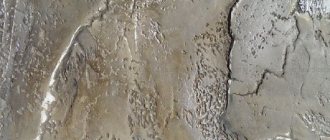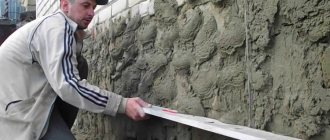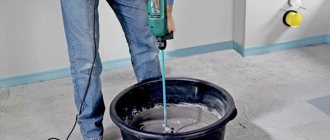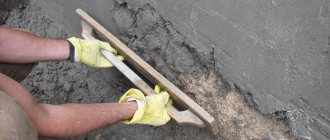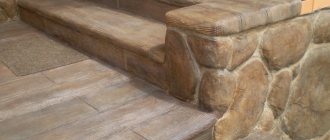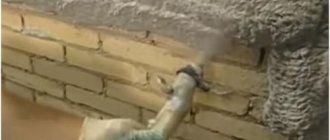If you want to extend the life of your cement plaster, you can treat the finished surface using a neutralizing solution that contains acid. Such a pickling will not only improve the quality of the mixture, but will also prevent the formation of house fungus and mold. Such solutions are widely available in construction stores. In this article we will give a couple of tips on how and with what etching of plaster is carried out.
What is etching?
What it is?
This process is the treatment of plastered walls in buildings where humidity is high. The solution is applied using a paint roller, brush or special sprayer.
It is undesirable to ignore the recommendations and neglect the etching procedure in rooms with a dry climate - it will be much more difficult to cope with overgrown colonies of pathogenic microflora.
Procedure for etching plaster
- First of all, it is necessary to prepare the surface for processing: clean it from dirt, remove old wallpaper or paint.
- The next step is to prepare the solution. When mixing ingredients, you must strictly follow the attached instructions and maintain the proportions.
- The finished suspension is applied to cleaned and dried walls using a regular paint brush, roller or sprayer. After finishing applying the neutralizing composition, the walls must be thoroughly dried.
- The final step is to rinse the treated surface with plain water to wash off the treatment products.
For what purpose is it performed?
Professional builders are well aware of what etching cement plaster with a neutralizing solution is, what this process is and what it is used for, as well as how important it is. Therefore, if repair work is performed by a specialist, you will not have to remind him about it.
In addition to the fact that etching helps to get rid of the spread of mold and mildew in conditions of high humidity, it can also significantly extend the service life of the cement base.
The procedure is carried out only on a completely dry surface - processing a wet composition loses all meaning.
Why stain plaster?
In general, etching a plastered surface with a neutralizing compound is used to extend the service life of cement plaster. In addition, treatment with such a composition protects the surface from the formation of fungus in the presence of dampness or moisture in the room being used. Completely dried plaster must be etched; there is no point in treating a wet solution.
Regardless of what solution you purchase, its composition will in any case contain some kind of acid in a certain amount. Any acid will not cause damage to cement plaster, but bacteria, fungi and microspores on the treated surface will certainly die.
It should be noted that plaster, no matter how strong it may seem, has no actual protection. Given the presence of pores in its structure, various microorganisms and spores often settle on the surface. Even if you paste wallpaper on a cement base, it still allows moisture to pass through, and pathogenic microflora forms under it. So etching must be done in any case.
What means should I use?
If cement plaster is to be etched with a neutralizing solution, the choice of material depends, first of all, on the budget. Specialized stores can offer a wide selection of products that are similar in principle of action and differ only in composition and pricing policy.
The main component of the solution is a special acid, which helps remove dangerous spores from the plaster. The most budget option would be copper sulfate and hydrochloric acid.
You should not use antifungal drugs, whiteness and various additives in the primer as a neutralizing agent - they will not have the desired effect.
Processing process
Etching cement plaster with a neutralizing solution is an excellent way to improve the technical characteristics of the material. This additional treatment helps extend the service life of the mixture and also prevents the appearance of fungus and mold on the slabs. This neutralizing solution contains a special acid. When etching plaster with this substance, it is imperative to adhere to all SNIPs. The process of working with this suspension should be performed as follows:
- Etching of cement plaster is carried out only in a room that is constantly well ventilated;
- The worker must have special gloves, face masks, respirators and gowns to protect against contact of chemicals in suspension with human skin, since the composition includes acid;
- If, during etching with a special agent, the mixture gets on your body or clothing, then rinse the area with plenty of water as soon as possible;
- Children and elderly people should not be in the premises during construction work.
Processing technology
The neutralizing solution must be applied using a simple brush, a regular paint roller or a construction sprayer. The main thing when etching plaster is to carry out all work extremely carefully, since this suspension is quite aggressive. After the wall has been completely treated, it is allowed to dry thoroughly, and then washed off with plenty of clean water. The main stages of all work are shown in the photo below.
When using a neutralizing solution for etching plaster, you must follow a certain sequence of work:
- First of all, prepare the walls for applying the solution (remove the wallpaper, strip off the paint and remove all dust and dirt);
- Carefully read the instructions for using the solution and in a special container mix all the components (taking into account the recommended ratio) that are included in the mixture. If you purchased ready-made etching, then simply add the specified amount of running water to it;
- Gently apply the suspension to the surface using a brush or roller;
- Wait until the mixture is absorbed into the plaster (about 15-20 minutes) and rinse off the entire substance with running water;
The entire process of etching the surface with a special neutralizing solution takes about half an hour, and anyone can do it, even without experience in the construction industry. The main rule when working with this aggressive suspension is to adhere to all safety rules. The end result will give you excellent results with complete safety for your health.
Applying plaster to walls is not a very complicated process (basic recommendations for carrying out such repairs can be seen in the video). If you have basic skills in working with construction tools and solutions, then you can independently carry out all the necessary stages of etching with a special suspension.
Security measures
Considering the fact that any neutralizing solution contains acid and other components harmful to the human body, in the process of surface treatment it is imperative to adhere to certain safety rules:
- It is mandatory to work in special clothing with long sleeves, closed shoes, gloves, a respirator and goggles in order to avoid liquid getting on exposed skin or mucous membranes;
- provide fresh air access to the room where processing takes place;
- do not allow children, elderly people and pets to be in the room being treated;
- If there is contact with a toxic liquid, the skin and mucous membranes are treated with a large volume of water, and the overalls are soaked and washed thoroughly.
Safety Rules and Remedies
When working with acid-containing suspensions, there are important nuances that can be neglected:
- the room where work is carried out must be well ventilated;
- exclude the possibility of strangers, including pets, appearing in the room;
- In case of direct contact with the solution, remove clothing and soak it, rinse skin with plenty of water.
Personal protective equipment is another safety item. Closed shoes, preferably rubberized ones, galoshes or boots are required. A work robe or other clothing, most importantly with long sleeves.
On the head: bandana, cap or scarf; protective glasses; a respirator to prevent inhalation of fumes.
Wear rubber gloves on your hands, the equipment is solid, but you should take care of your health.
Sequence of work
The technology for etching cement plaster with a neutralizing solution is not difficult, but during the work you must adhere to certain rules and sequence of actions.
The step-by-step work algorithm is as follows:
- cleaning the surface, if necessary (remove old wallpaper, layers of paint, dust, dirt);
- preparing the mixture with strict adherence to the dosage and preparation instructions;
- direct application of the solution;
- natural drying process;
- neutralize product residues by rinsing with cold water.
The procedure for etching cement plaster
The work order can be divided into stages:
- removal of contaminants from the treated surface;
- preparing the mixture, strictly observing the dosage;
- applying the solution by spray or roller;
- natural drying;
- washing the walls with cold water to neutralize treatment products.
The composition does not form a film, but actively penetrates the structure of the cement-sand mixture, entering into a chemical reaction with it. Before the washing stage, streaks and stains may appear on the wall. When the etching is completed, after final drying, you can begin to continue the repair.
The technology for etching cement plaster is simple, but all steps must be followed strictly. Without taking into account drying, the work will take no more than half an hour; do not neglect it in order to avoid problems in the future.
What to consider?
The neutralizing solution for plaster is not capable of forming a film on the surface like paint; it penetrates deeply into the coating and there it reacts with the components of the cement. Therefore, the appearance of specific stains and stains on etched walls becomes a common occurrence. This depends on the quality of the solution and its composition. The final step is to wash off the reaction products from the wall.
After washing off the remaining substance from the treated surface, you need to let it dry completely, and only then apply a primer or facing coating.
It is also worth taking care to create unfavorable conditions for the subsequent development of fungi. Their spores will not share as actively if indoors:
- normal regular air ventilation is ensured;
- The walls were whitewashed using lime (we are talking about utility rooms and especially wet rooms).
If all important process conditions and safety rules are observed when performing work, then etching an average-sized room takes no more than 1 hour.
How long does it take for cement plaster to dry?
The drying time of cement plaster is of interest to builders who independently level the walls in a private house or city apartment. Here you should pay attention to the fact that the plaster layer does not dry for the same amount of time. This depends on the base surface material and the thickness of the plaster.
At temperatures in the living room at +17...+25 degrees and air humidity within 75%, a 2-centimeter layer of cement plaster will dry within 12-14 hours. This is the standard drying time, but it is advisable to extend it to a day. The above requirement applies to a wooden base. If the layer is increased to 4 centimeters, the drying time of the solution will increase by approximately 40%.
Drying of cement plaster on a concrete base takes 2-3 hours longer. In addition, the time increases in proportion to the increase in the thickness of the screed. In the case of applying the leveling mixture to sheets of plasterboard, the drying time of a 2-centimeter layer corresponds to 8...10 hours, because gypsum plaster boards are a dry, perfectly level base. Drying should occur naturally; when using a hair dryer to heat the screed, there is a high probability of cracks appearing on the leveled walls.
Solutions for cement plaster
CS are produced in the form of a dry mixture or a ready-made solution - much less commonly. The components of the mixture are commercially available, so leveling and decorative plasters are often produced independently. So, how to make cement mortar for plaster?
Composition and structure
The basis of the mixture is cement, and this material itself has a complex composition and is classified according to strength, frost resistance, water resistance and other factors. Different cements are chosen for different jobs.
- Thus, for interior work, grade M150 or M200 is allowed;
- for finishing the facade you will need a grade of at least M300;
- if the building is exposed to aggressive chemical substances, then you will have to choose M400 or M500 cement.
The second required component is quartz sand, river or quarry. The main requirement here is the absence of clay, silt, and dust impurities. Therefore, before use, quartz sand is thoroughly cleaned - sifted and soaked.
The sand fraction is selected based on the purpose of the plaster:
- small and thin - for a decorative covering layer,
- medium and large - for leveling and sealing cracks and rusts.
Special additives on an organic basis are introduced into the mixture. Their role is to improve the properties of mixtures.
Recipe
To achieve the best result, the composition of the solution is changed for the primer layer, covering and spraying.
For cement-lime plaster, solutions are selected as follows:
- for spraying, mix 1 share of cement, 0.7–1 share of lime and 2.5–4 shares of sand;
- for the base layer you will need 1 part cement, 3–5 parts sand and 0.3–0.5 parts lime;
- for covering you need to combine 1.1–1.5 parts of cement, 1 part of lime and 1.4–2 parts of sand.
For cement-sand mortar the following proportions are correct:
- for spraying, combine 1 part of cement with 2–3 parts of sand;
- for the base - 2.5–4 shares of sand are mixed with one share of cement;
- for covering, combine 1 part of cement with 1.5–1 part of sand.
Such ratios are considered optimal. The recipe for decorative plasters also includes coloring pigments or other fillers - marble chips, granite, tuff. And various modifiers are introduced into the composition of special-purpose CS.
Supplements
The most sought-after property when applying a plaster layer is plasticity. This quality makes it possible to achieve the most uniform distribution of mass, and on the other hand, to simulate the coating, forming a relief. The CS itself is not very plastic, and in order to increase this property, special additives are added to the composition:
- PVA glue is the “simplest” component that is in demand when making it yourself. It requires 50–100 ml for every 10 liters of prepared solution;
- liquid soap performs the same role ;
- cellulose ethers - the additive increases water retention, which ensures high-quality hardening of the binder over a very wide temperature range;
- redispersible powders - obtained by drying an aqueous dispersion of latexes. When mixing the mixture with water, such particles are dispersed again, which provides a number of properties: the plasticity time increases, the volume of required water decreases, the bending strength increases, which means the absence of cracks, and even the adhesive ability increases;
- starch esters - affect the workability of the mixture, for example, they reduce the tendency to slip, increase adhesion, which makes application easier, and so on;
- biocides – increase the resistance of the coating to fungus and mold.
